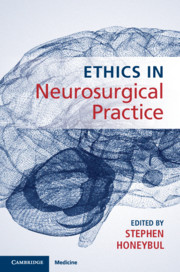Book contents
- Ethics in Neurosurgical Practice
- Ethics in Neurosurgical Practice
- Copyright page
- Contents
- Contributors
- Introduction
- Part I General Ethics
- Part II Neurosurgery-Specific Bioethics
- Chapter 10 A Historical Overview of Ethics in Neurosurgery
- Chapter 11 Evidence-Based Neurosurgery: Principles, Applicability, and Challenges
- Chapter 12 Ethical Challenges of Neurosurgical Care for Brain Tumour Patients
- Chapter 13 Severe Traumatic Brain Injury
- Chapter 14 ‘Malignant’ Middle Cerebral Artery Infarction
- Chapter 15 Aneurysmal Subarachnoid Haemorrhage
- Chapter 16 Paediatric Neurosurgery
- Chapter 17 Spinal Neurosurgery
- Chapter 18 Ethical Challenges in Psychosurgery: A New Start or More of the Same?
- Chapter 19 Brain Death and Organ Donation
- Part III Future Developments
- Index
- References
Chapter 19 - Brain Death and Organ Donation
from Part II - Neurosurgery-Specific Bioethics
Published online by Cambridge University Press: 29 May 2020
- Ethics in Neurosurgical Practice
- Ethics in Neurosurgical Practice
- Copyright page
- Contents
- Contributors
- Introduction
- Part I General Ethics
- Part II Neurosurgery-Specific Bioethics
- Chapter 10 A Historical Overview of Ethics in Neurosurgery
- Chapter 11 Evidence-Based Neurosurgery: Principles, Applicability, and Challenges
- Chapter 12 Ethical Challenges of Neurosurgical Care for Brain Tumour Patients
- Chapter 13 Severe Traumatic Brain Injury
- Chapter 14 ‘Malignant’ Middle Cerebral Artery Infarction
- Chapter 15 Aneurysmal Subarachnoid Haemorrhage
- Chapter 16 Paediatric Neurosurgery
- Chapter 17 Spinal Neurosurgery
- Chapter 18 Ethical Challenges in Psychosurgery: A New Start or More of the Same?
- Chapter 19 Brain Death and Organ Donation
- Part III Future Developments
- Index
- References
Summary
Transplantation using organs obtained around the time of death began in 1962 and has become a large and very successful enterprise. In Australia, around 500 organ donors currently provide about 1,500 organs for transplantation per year. Success rates of the order of 90% are now achievable, but currently the demand for organs for transplantation greatly exceeds supply.
- Type
- Chapter
- Information
- Ethics in Neurosurgical Practice , pp. 193 - 204Publisher: Cambridge University PressPrint publication year: 2020



